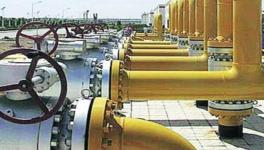KG Basin deal : Murky valuation of Gas prices & Production costs
Former principal advisor (energy) to the Planning Commission, Surya Sethi comments on the recent CAG draft report on the Production Sharing Contract between the government and Reliance Industries Limited for exploration of gas in the Krishna Godavari Basin.
Former principal advisor (energy) to the Planning Commission, Surya Sethi comments on the recent CAG draft report on the Production Sharing Contract between the government and Reliance Industries Limited for exploration of gas in the Krishna Godavari Basin.
Rough Transcript
Prabir Purkayastha (PP): Hello and welcome to the Newsclick. Today, we have with us Dr. Surya Sethi Former Principal Advisor, Energy to the Planning Commission and well known energy expert. Surya good to have you with us.
Surya Sethi (SS): Thank you Prabir.
PP: The CAG report has raised serious questions regarding production sharing contract with Reliance and as well as with other companies. Do you think that the production sharing contract now will be reviewed by the government in light of the CAG comment or is it that they will go with the same policy as they were doing in the past?
SS: There are many flaws in the production sharing contract and it is not the first time that these flaws have been pointed out. The big flaw that CAG has pointed out is he calls it a perverse kind of incentive where the government share actually reduces as the capital cost goes up. I personally don't think that is that as bad as it is being made out to be. The problem is not what happens with government's share because remember we are an energy starved country and we need more energy. So if we can recover additional amounts of energy by putting in extra capital it may be well worth it given the fact that we are in – the problem with it is that we have no clue what the right capital cost should be for extracting a certain amount of energy. So as I say stealing and corruption they are all perverse if you have no fear of getting caught. The problem is that cost go up and we recover some extra energy. The problem is we have no clue what the right cost recover the energy and that is the essence of the problem of D6 and CAG.
PP: Pent up from 2.5 billion to 8.5 billion and according to CAG even this is likely to go further.
SS: It will go further because if you have to produce ATO and CMDA gas fields from these it is not going to produce from these bottlenecks that are taking place. In fact, it will ever produce that I am not sure. But the point that I wanted to make is neither we are sure whether 2.2 was correct, nor are we sure 8.2 is correct. There is tremendous amount of asymmetry of information between people who are putting up these cost and approving these costs are legitimate. There are two other issues that are involved. One is of course the fact there is an exploration area to which you are only supposed to hold only the discovery, discovered area as well as the production area. But in the case of Reliance, it's been allowed to hold hundred percent production area to the development area, production area would be only five percent of this area. Do you think that this is something that immediately needs action. SS: I think, CAG has done great service in pointing out that this contract has been violated. We haven't have heard the explanation at least the general public has heard explanation from the other side, how come this has happened because it is very well laid out in the production sharing contract hereby you have to relinquish areas that you have not actually started production from within the given period of time. Now, how that was not implemented in this I think is a biggest single contribution that I found out of the CAG report because even I was not aware that this is actually happening. As I have said, I have not heard the other side of the story I don't know what the explanation they will come up with as to what prompted the CAG to permit this but as I said as far as the PACs are concerned, this is the clear violation of PAC.
PP: All the production contract seems to take international parity price which is the basis for oil at least. For gas, it was fixed by EGoM headed by Pranab Mukherjee at $4.2/mBtu when the cost for the gas as per the case they fought with Reliance fought with Anil Ambani's Reliance, as that the cost, they would have made profit even if it was sold at $2.4 /mBtu. Now, what justification is there for setting up such a high prices plus the fact that it has set up in international terms oil price and international oil price and exchange of dollars.
SS: Prabir, I have a very personal grudge here because I showed to that EGoM samples from 53 or 63 countries I forget of how gas is priced. I showed them not one of the countries prices gas as we are pricing gas. The problem is that what we are talking of here is natural gas. The way natural gas is priced is very different from the way LNG is priced. What we agreed to do was to price natural gas as LNG level. Not only we agreed to price natural gas on level formula, we also agreed to a formula which had no resemblance with the formula for LNG pricing also in the world. This was categorically told to EGoM in writing and they still did not listen. The fact of the matter is $4.2 valid price for natural gas and I am again emphasise on natural gas is the highest price that anybody has received for natural gas anywhere. And while you say cost of production you know various figures came out somebody has said one dollar but nobody has claimed cost of production more than 1.43 or some such number but there are numbers to show probably it is 99 cents also. But wherever they are, the maximum number is 1.43. Why under that situation we are paying for .2 dollars is completely is beyond me at least. As I said, this was discussed, this was demonstrated this is not the way to price natural gas but yet the EGoM decided to go with that price.
PP: one part of the cost what are you talking about is of course is the 8.8 billion dollar capital investment and though CAG has not gone into the details of this, there was some report that indicate that this was a proof 2.5 billion to 8.8 billion was approved in a matter of 53 days. He also said that the government really did not have the expertise on this. Have you done any studies to indicate what this costing is, how this prices arrived at.
SS: Time and again this has again this issue has come up. This is not the first time that this cost increase has came up. I mean today we have a CAG report but internally this issue was debated time and time again as to how this cost issue has to be approved. At least 8 or 9 years I was in the government, I did not see any legitimate justification for this cost increase.
PP: Production sharing contracts, has the government ever received what it was committed by the oil companies, companies like Reliance.
SS: That's very good point that you have asked. The problem of this is one point which the CAG has missed is when we share the government share rises as you achieve a certain investment multiple. Underlying assumption is by the time you achieve the investment multiple, there would be some resource left to share. But you actually look at the numbers and the capacities of this wells there would be no resource left to share by the time by the time investment multiple is achieved. So that's the beauty of this rising capital cost because with this rising capital cost, the investment multiple is assured and by the time you have recovered, reached that investment multiple there will be no gas left to share. So no matter you may give the government 85 percent share beyond a certain investment multiple 85 percent share of a zero is still a zero. That's a harsh reality that has come out of the CAG report. I have been asking as to show me among the private fields, ONGC is a separate kettle of fish but among the private fields I would love to know how much has profit petroleum, how much profit of gas the government benefited from the private fields.
PP: Effectively, what it would seem to imply therefore is by cooking capital cost figures by the way it is also the Enron case that you cook the capital cost figures of course you would get the higher price. By cooking the capital cost figures, you may profit really in two ways. One is of course, recycle the funds back to the company and second is of course is that also you also get the share of the profit petroleum, but there is a third issue, by inflating all these, Reliance can also boost it's stock price and this is one things which Reliance seem to have been doing continuously.
SS: Well, again if you look at the earlier balance sheet of Reliance, to the best of my knowledge DGH by then only certified 7 trillion cubic feet of gas. But reports were claiming much differently from there. This should not happen anywhere else in the world. This was only possible there and does impact stock prices. The deficiency is independent regulation and regulation by people who know this sector, people who are expert from this sector who are equal in their, there is no asymmetry between their knowledge base and the private sector whoever is proposing these things to them. Unless we get that kind of regulation place, that kind of expertise and that level of independence we will always face the problem whether 2.2 is right or 8.8 is right or neither is right.
PP: So lot of this could have been just this increase of gas reserves as Reliance claim without a verification could verily easily have been just boost stock price and recover some money.
SS: Well, we see the results today, you know they said they can produce 80 mmcmd Today, from whatever I am reading you know my friends I am gathering, this is turned out of the biggest disaster fields of the country because we are not able to produce today 43 – 44 mmcmd which was the original level. Everybody felt that at 40 mmcmd, the field will last 14 or 15 years but I have never seen data to confirm that 80 mmcmd the field life would still be rare. You can extract 80 mmcmd from the same field but you will kill the field in 3 years or 4 years of time.
PP: As you seen from what the data is.
SS: The government can wait for 85 percent share of something that will never show up.
PP: Thanks Surya, think has been a very interesting discussion and let's see what's the government's reply is going to be on draft CAG report. SS: I look forward for reading that myself.
PP: Thank you.
Get the latest reports & analysis with people's perspective on Protests, movements & deep analytical videos, discussions of the current affairs in your Telegram app. Subscribe to NewsClick's Telegram channel & get Real-Time updates on stories, as they get published on our website.
























